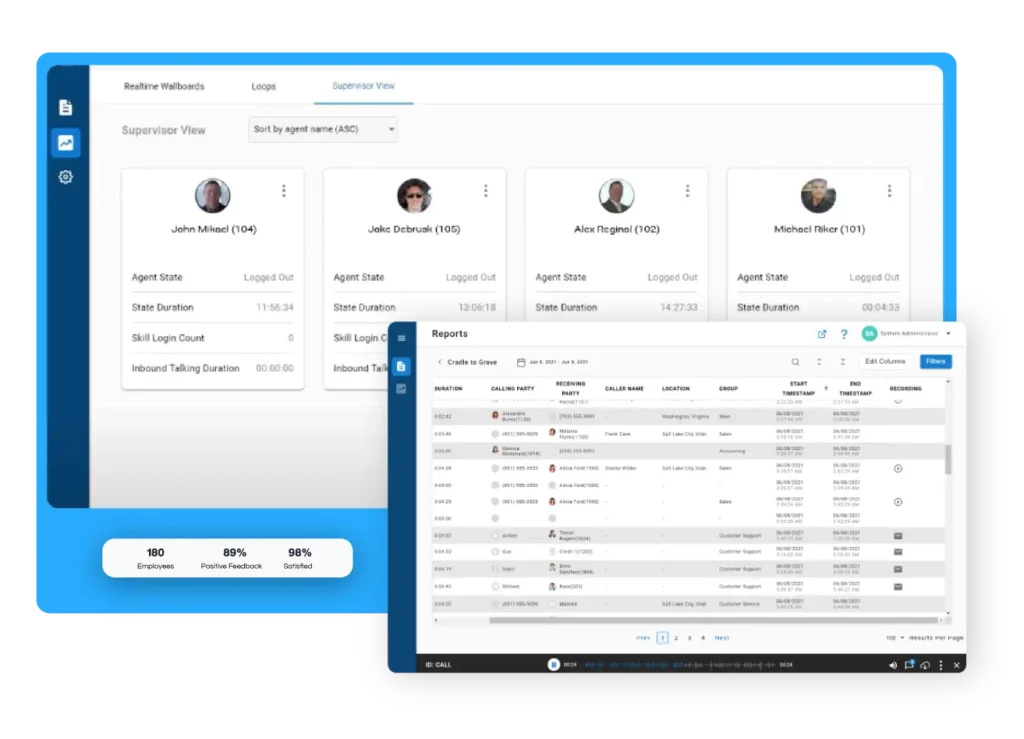Ever wonder what your customers are really telling you? Conversation analytics takes the guesswork out of interpreting calls, chats, and messages by turning every interaction into actionable data. Businesses are increasingly turning to this tool to boost performance, uncover customer sentiment, and fine-tune their teams in real time. In this blog, we’ll break down what conversation analytics is, how it works, and why it’s becoming an essential part of modern contact center strategy.
Key Takeaways
- Conversational analytics uses AI technologies like natural language processing and machine learning to analyze unstructured customer interactions and uncover key insights.
- It turns conversations into insights by collecting and transcribing conversations, then using AI to analyze language, sentiment, and patterns before delivering insights through dashboards and reports.
- The primary benefits of conversation analytics are that businesses gain clearer visibility into customer experiences, boost sales performance, and streamline operations for improved efficiency across teams.
What Is Conversation Analytics?
Conversation analytics, also called conversational analytics, is the process of capturing and analyzing voice and text-based interactions to uncover insights about customer behavior, agent performance, and overall contact center operations. It goes far beyond simply recording calls or saving chat transcripts; every word, pause, and sentiment can be translated into meaningful data points that help you see the full story behind every interaction.
For contact centers, conversation analytics is a game-changer. Traditional analytics rely heavily on structured data like call duration, hold time, or resolution rates. While useful, those metrics only scratch the surface. Conversation analytics delves deeper by interpreting natural language to provide context, tone, and emotion. It helps you understand not just what happened during a conversation, but why it happened.
How Does Conversational Analytics Work?
Turning raw conversations into powerful insights doesn’t happen by accident. Conversational analytics uses a combination of AI-driven technologies and smart processes to capture, analyze, and interpret every interaction. For contact centers, this means having a deeper understanding of customer needs and agent performance without digging through hours of recordings.
Every conversation analytics tool works a bit differently, but they generally involve:
1. Data Collection
Everything starts with capturing the conversation. This can include call recordings, live chat logs, SMS messages, and even email exchanges. Every customer interaction, regardless of channel, becomes a valuable data source for analysis.
2. Transcription/Ingestion
For audio conversations, AI-powered speech-to-text technology transcribes spoken words into readable text. For written channels like chat or email, the system ingests the raw text directly. This stage sets the foundation for speech analysis.
3. Data Pre-processing
Next, the system cleans the data. It removes background noise, filler words, and irrelevant content. This ensures that only accurate, usable information is analyzed in the next stage.
4. Natural Language Processing
Once the data is cleaned, Natural Language Processing (NLP) and machine learning are used to analyze the content of each conversation. They break down what was said, how it was said, and what it means. This process identifies key topics and keywords, picks up on sentiment (positive, negative, or neutral), and spots trends across thousands of interactions. This gives you a clear picture of common customer concerns, agent strengths, and opportunities for improvement.
5. Reporting & Visualization
Once processed, insights are delivered through dashboards, automated reports, and alerts. These visual tools make it easy for managers to monitor trends, identify coaching opportunities, and take action quickly.
6. Actionable Insights
The ultimate goal of conversation analytics is to drive smarter decisions. The insights uncovered through this process enable teams to take meaningful action that optimizes performance and delivers better experiences.
Benefits of Implementing Conversation Analytics
Conversation analytics gives businesses a clearer view of what customers are saying and how teams are responding. It offers benefits like:
Improved Customer Experience (CX)
Analyzing conversations helps uncover what customers care about most. Teams can identify pain points, track sentiment, and better understand preferences. This leads to more personalized support and stronger customer relationships.
Enhanced Sales Performance
Sales teams can learn what messaging works, which objections come up most often, and how top performers handle tough calls. These insights make it easier to refine sales strategies and increase conversions.
Product and Service Improvement
Conversations often include direct feedback on products and services. Teams can use this data to find common issues, spot unmet needs, and guide product development efforts.
Operational Efficiency
Frequent questions, repeated issues, and slow processes can all be spotted through conversation analysis. With this information, businesses can streamline operations, improve workflows, and reduce costs.
Risk Mitigation and Compliance
Monitoring conversations helps detect risky language, non-compliant behavior, and potential fraud. This reduces the chance of legal or reputational damage and helps ensure quality across every interaction.
Real-World Applications of Conversational Analytics
Conversation analytics isn’t limited to one type of business or department. It’s a versatile tool that turns everyday interactions into high-impact insights across industries. Let’s explore some real-world examples of conversation analytics in use.
Customer Service
Support teams use conversation analytics to identify recurring issues, customer frustrations, and training gaps. With clear visibility into what customers are struggling with, managers can fine-tune workflows, coach agents more effectively, and deliver better experiences across the board. Discover how it’s transforming support in complex environments like manufacturing.
Sales and Marketing
Sales and marketing teams use conversational data to better understand what prospects are thinking. Analytics can surface recurring objections, highlight which pitches are working, and identify ideal moments for upselling or cross-selling. Marketing can also refine messaging based on actual customer language, making campaigns more relevant and aligned with buyer intent. It’s a direct line to what your audience wants.
Product Development
When customers report bugs or suggest improvements, it often happens in conversations rather than surveys or feedback forms. Conversational analytics captures this unfiltered feedback and turns it into clear, actionable insight for product teams. Developers and designers can spot patterns in complaints, identify requested features, and prioritize fixes based on real user needs.
Healthcare
Communication is critical in healthcare. Conversational analytics helps providers analyze patient interactions to uncover common concerns, improve bedside manner, and streamline appointment scheduling or follow-up care. Understanding what patients are asking, feeling, or struggling with enables healthcare teams to improve service delivery and boost patient satisfaction.
Financial Services
For financial institutions, maintaining compliance and protecting sensitive information is non-negotiable. Conversational analytics helps monitor every customer interaction for risky language, deviations from scripts, or signs of fraud. It also supports auditing and reporting for regulatory purposes.
Make Smarter Business Decisions with Conversational Analytics
Every call, chat, or message holds valuable insight—you just need the right tools to uncover it. With conversation analytics from Xima, you can make smarter decisions, improve team performance, and deliver experiences your customers will remember for the right reasons.
Want to see how it works? Book a demo and let our team show you how Xima helps turn everyday interactions into powerful business intelligence.
FAQs about Conversation Analytics
Conversation analytics gives call center leaders a deeper understanding of what’s really happening in customer interactions. By analyzing tone, sentiment, keywords, and patterns, it highlights where agents are thriving and where they need support. The result is better performance, faster resolutions, and a more consistent customer experience.
Conversation analytics platforms are built with security and compliance in mind. Conversations are encrypted, access is controlled, and sensitive data can be automatically redacted or flagged. Businesses can also set rules to ensure interactions meet regulatory requirements.
Intent recognition uses natural language processing (NLP) and machine learning to understand why a customer is reaching out. It analyzes the words, context, and sentiment in a conversation to determine the customer’s goal, like needing tech support, asking about billing, or requesting a refund. This can help route conversations more efficiently, reduce handle time, and deliver faster, more targeted support.



